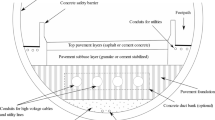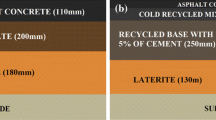Abstract
A lack of proper base and subbase materials in pavement construction is one of the common problems in the tropical region worldwide. In many countries such as Thailand, cementitious materials are usually used for ground improvement. Controlled Lowstrength Material (CLSM) was considered in this study as a pavement base material. The CLSM mixes were prepared by varying cement, fly ash and fine aggregate content. Each mixed component was studied for their physical and chemical properties. After mixing, properties of the CLSM were investigated based on the standard testing of fresh concrete and cement-treated base material. The flowability, setting time and bleeding were checked to ensure that the CLSM were self-compacting. The mechanical properties of hardened CLSM were determined by means of CBR, unconfined compressive strength and resilient modulus tests. The resilient modulus results were used in the analytical design of flexible pavement with CLSM base. The critical traffic data under high-volume road collected by the Thailand Department of Highway was adopted in this study. Results show that the CLSM base considerably increased the performance as well as design life of asphalt pavement compared with the conventional crush rock base pavement.
Similar content being viewed by others
References
AASHTO T307 (2007). Standard method of test for determining the resilient modulus of soil and aggregate materials, American Association of State Highway and Transportation Officials, Washington, D. C.
Achtemichuk, S., Hubbard, J., Sluce, R., and Shehata, M. H. (2009). “The utilization of recycled concrete aggregate to produce controlled low-strength materials without using Portland cement.” Cement and Concrete Composites, vol. 31, no. 8, pp. 564–569, DOI: 10.1016/j.cemconcomp.2008.12.011.
ACI Committee 229 (1999). Controlled low strength materials (ACI 229R), American Concrete Institute, Farmington Hill, Michigan, USA.
Asphalt Institute (1991). Thickness design: Asphalt pavements for highways and streets, Manual Sesies No. 1 (MS-1), Lexington, Kentucky, USA.
ASTM Designation C 231 (2017). Standard test method for air content of freshly mixed concrete by the pressure method, Philadelphia, USA, DOI: 10.1520/C0231_C0231M-17A.
ASTM Designation C 232 (2014). Standard test methods for bleeding of concrete, Philadelphia, USA, DOI: 10.1520/C0232_C0232M.
ASTM Designation C 403 (2016). Standard test method for time of setting of concrete mixtures by penetration resistance, Philadelphia, USA, DOI: 10.1520/C0403_C0403M-16.
ASTM Designation C 939 (2016). Standard test method for flow of grout for preplaced-aggregate concrete (flow cone method), Philadelphia, USA, DOI: 10.1520/C0939_C0939M-16A.
ASTM Designation C 1611 (2014). Standard test method for slump flow of self-consolidating concrete, Philadelphia, USA, DOI: 10.1520/C1611_C1611M-14.
ASTM Designation D 1883 (2016). Standard test method for California Bearing Ratio (CBR) of laboratory-compacted soils, Philadelphia, USA, DOI: 10.1520/D1883-16.
ASTM Designation D 2166 (2016). Standard test method for unconfined compressive strength of cohesive soil, Philadelphia, USA, DOI: 10.1520/D2166_D2166M-16.
ASTM Designation D 4832 (2010). Standard test method for preparation and testing of Controlled Low Strength Material (CLSM) test cylinders, Philadelphia, USA, DOI: 10.1520/D4832-16.
Bamrungpong, W., Chuejedton, N., Likitlersuang, S., Jongvivatsakul, P., and Chompoorat, T. (2017). “A study of properties of controlled low–strength material made from fly ash utilized as pavement base material.” Engineering Journal of Research and Development, vol. 28, no. 4, pp. 15–26 (In Thai).
Chindaprasirt, P., Jaturapitakkul, C., and Sinsiri, T. (2005). “Effect of fly ash fineness on compressive strength and pore size of blended cement paste.” Cement and Concrete Composites, Vol. 27, pp. 425–428, DOI: 10.1016/j.cemconcomp.2004.07.003.
Chompoorat, T. and Likitlersuang, S. (2015). “Laboratory investigation of hot mix asphalt behaviour for mechanistic-empirical pavement design in tropical countries.” Geotechnical Engineering Journal of the SEAGS & AGSSEA, vol. 46, no. 1, pp. 37–44.
Chompoorat, T. (2012). “Dynamic properties of cement treated clay.” The Seventh Asian Young Geotechnical Engineers Conference (7AYGEC), Tokushima, Japan, pp. 273–279.
Department of Highways (2001). Analytical design of new flexible pavements in Thailand, Pavement Technology Project, Department of Highways, Thailand.
Do, T. M., Kim, Y., and Dang, M. Q. (2017). “Influence of curing conditions on engineering properties of controlled low strength material made with cementless binder.” KSCE Journal of Civil Engineering, vol. 21, no. 5, pp. 1774–1782, DOI: 10.1007/s12205-016-0731-y.
EFNARC (2002). Specification and guidelines for self-compacting concrete: Surrey, UK.
Gabr, M. A. and Bowders, J. J. (2000). “Controlled low-strength material using fly ash and AMD sludge.” Journal of Hazardous Materials, vol. 76, Nos. 2–3, pp. 251–263, DOI: 10.1016/S0304-3894(00) 00202-8.
Gupta, A., Kumar, P., and Rastogi, R. (2014). “Mechanistic–empirical approach for design of low volume pavements.” International Journal of Pavement Engineering, vol. 16, no. 9, pp. 797–808, DOI: 10.1080/10298436.2014.960999.
Heukelom, W. and Klomp, A. J. G. (1962). “Dynamic testing as a means of controlling pavements during and after construction.” International Conference on the Structural Design of Asphalt Pavements, Ann Arbor, Michigan, pp. 667–679.
Horpibulsuk, S., Rachan, R., Suddeepong, A., and Chinkulkijniwat, A. (2011). “Assessment of strength development in blended cement admixed Bangkok clay.” Construction and Building Materials, vol. 25, pp. 1521–1531, DOI: 10.1016/j.conbuildmat.2010.08.006.
Huang, Y. H. (2004). Pavement analysis and design, 2nd edition, Prentice Hall, Upper Saddle River, New Jersey.
Jongpradist, P., Jumlongrach, N., Youwai, S., and Chucheepsakul, S. (2010). “Influence of fly ash on unconfined compressive strength of cement-admixed clay at high water content.” Journal of Materials in Civil Engineering, vol. 22, no. 1, pp. 49–58, DOI: 10.1061/(ASCE) 0899-1561(2010)22:1(49).
Katz, A. and Kovler, K. (2004). “Utilization of industrial by-products for the production of Controlled Low Strength Materials (CLSM).” Waste Management, vol. 24, no. 5, pp. 501–512, DOI: 10.1016/S0361-3682(02)00026-0.
Kim, D. and Kim, J. R. (2007). “Resilient behavior of compacted subgrade soils under the repeated triaxial test.” Construction and Building Materials, vol. 21, no. 7, pp. 1470–1479, DOI: 10.1016/j.conbuildmat.2006.07.006.
Kim, Y., Do, T. M., Kim, H., and Kang, G. (2016). “Utilization of excavated soil in coal ash-based Controlled Low Strength Material (CLSM).” Construction and Building Materials, vol. 124, pp. 598–605, DOI: 10.1016/j.conbuildmat.2016.07.053.
Kuo, W. T., Wang, H. Y., Shu, C. Y., and Su, D. S. (2013). “Engineering properties of controlled low-strength materials containing waste oyster shells.” Construction and Building Materials, vol. 46, pp. 128–133, DOI: 10.1016/j.conbuildmat.2013.04.020.
Likitlersuang, S. and Chompoorat, T. (2016). “Laboratory investigation of the performances of cement and fly ash modified asphalt concrete mixtures.” International Journal of Pavement Research and Technology, vol. 9, no. 5, pp. 337–344, DOI: 10.1016/j.ijprt.2016.08.002.
May, R. W. and Witczak, M. W. (1981). “Effective granular modulus to model pavement response.” Transportation Research Record, No. 810, Transportation Research Board, pp. 1–9.
Miren, E., Javier, A., Eugenia, P. M., and Alain, G. (2013). “Use of recycled fine aggregates for Control Low Strength Materials (CLSMs) production.” Construction and Building Materials, vol. 44, pp. 142–148, DOI: 10.1016/j.conbuildmat.2013.02.059.
Muniandy, R., Aburkaba, E. E., and Thamer, N. (2013). “Comparison of flexible pavement performance using Kenlayer and Chev PC software program.” Australian Journal of Basic and Applied Sciences, vol. 7, no. 9, pp. 112–119.
National Cooperative Highway Research Program (NCHRP) (2000). Unbound materials characterization utilizing LTPP Data, Unpublished Interim Task Report Project 1-37A, Development of the 2002 Design Guide for the Design of New and Rehabilitated Pavement Structures, National Research Council, Washington D.C.
Pedarla, A., Puppala, A. J., Savigamin, C., and Yu, X. (2015). “Performance of sand-treated clay subgrade supporting a low-volume flexible pavement.” Transportation Research Record: Journal of the Transportation Research Board, No. 2473, pp. 91–97, DOI: 10.3141/2473-11.
Puppala, A. J., Hoyos, L. R., and Potturi, A. K. (2011). “Resilient moduli response of moderately cement-treated reclaimed asphalt pavement aggregates.” Journal of Materials in Civil Engineering, vol. 23, no. 7, pp. 990–998, DOI:10.1061/(ASCE)MT.1943-5533.0000268.
Selvi, P. (2015). “Fatigue and rutting strain analysis on lime stabilized subgrades to develop a pavement design chart.” Transportation Geotechnics, vol. 2, pp. 20–29, DOI: 10.1016/j.trgeo.2014.09.001.
Taesiri, Y. and Jitareekul, P. (2002). An engineering manual highway pavement design, Training on Sustainable Road Development, Road and Pavement Design Branch Department of Highways, Thailand.
Wang, H. Y. and Chen, K. W. (2016). “A study of the engineering properties of CLSM with a new type of slag.” Construction and Building Materials, vol. 102, pp. 422–427, DOI: 10.1016/j.conbuildmat.2015. 10.198.
Wen, H., Muhunthan, B., Wang, J., Li, X., Edil, T., and Tinjum, J. M. (2014). Characterization of cementitiously stabilized layers for use in pavement design and analysis (NCHRP Report No. 789), Washington, D.C.: National Cooperative Highway Research Program.
Wu, H., Huang, B., Shu, X., and Yin, J. (2016). “Utilization of solid wastes/by products from paper mills in Controlled Low Strength Material (CLSM).” Construction and Building Materials, vol. 118, pp. 155–163, DOI: 10.1016/j.conbuildmat.2016.05.005.
Author information
Authors and Affiliations
Corresponding author
Rights and permissions
About this article
Cite this article
Chompoorat, T., Likitlersuang, S. & Jongvivatsakul, P. The Performance of Controlled Low-strength Material Base Supporting a High-volume Asphalt Pavement. KSCE J Civ Eng 22, 2055–2063 (2018). https://doi.org/10.1007/s12205-018-1527-z
Received:
Revised:
Accepted:
Published:
Issue Date:
DOI: https://doi.org/10.1007/s12205-018-1527-z




